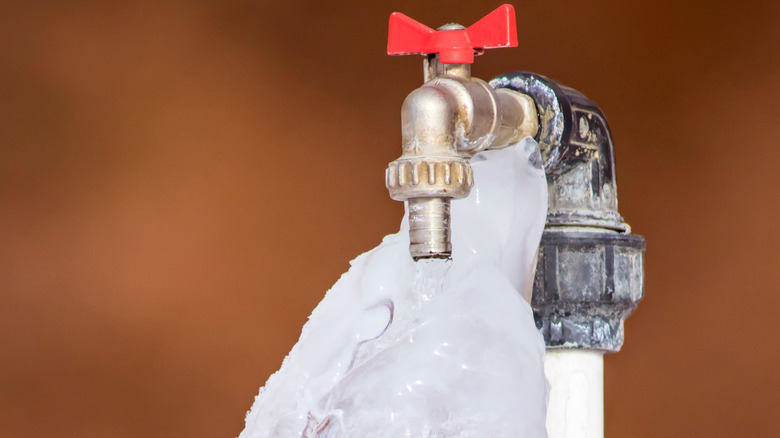Essential Tips to Protect Against Frozen Plumbing in Cold Weather
Essential Tips to Protect Against Frozen Plumbing in Cold Weather
Blog Article
How do you really feel about Prevent Frozen Pipes ?

Winter can damage your pipes, specifically by freezing pipes. Right here's exactly how to stop it from occurring and what to do if it does.
Introduction
As temperatures drop, the risk of frozen pipes rises, potentially leading to pricey repair services and water damages. Understanding just how to avoid frozen pipes is essential for property owners in chilly climates.
Avoidance Tips
Insulating susceptible pipes
Wrap pipes in insulation sleeves or utilize heat tape to secure them from freezing temperature levels. Concentrate on pipelines in unheated or exterior locations of the home.
Home heating strategies
Keep indoor rooms effectively heated up, especially locations with pipes. Open cabinet doors to enable warm air to distribute around pipes under sinks.
How to determine frozen pipes
Search for decreased water flow from taps, uncommon smells or sounds from pipelines, and noticeable frost on subjected pipes.
Long-Term Solutions
Structural modifications
Think about rerouting pipes away from outside walls or unheated locations. Add extra insulation to attic rooms, cellars, and crawl spaces.
Upgrading insulation
Buy high-grade insulation for pipes, attic rooms, and walls. Appropriate insulation helps preserve constant temperatures and lowers the danger of icy pipes.
Securing Exterior Plumbing
Garden pipes and exterior taps
Disconnect and drain garden pipes prior to winter months. Install frost-proof spigots or cover exterior taps with shielded caps.
Understanding Frozen Pipes
What creates pipelines to ice up?
Pipes freeze when exposed to temperatures listed below 32 ° F (0 ° C) for expanded durations. As water inside the pipes freezes, it expands, taxing the pipe walls and possibly creating them to rupture.
Risks and problems
Frozen pipelines can result in water supply disturbances, property damage, and expensive repair services. Burst pipelines can flood homes and create comprehensive architectural damage.
Signs of Frozen Pipeline
Recognizing frozen pipelines early can prevent them from breaking.
What to Do If Your Pipelines Freeze
Immediate actions to take
If you presume icy pipes, keep faucets open up to eliminate pressure as the ice melts. Make use of a hairdryer or towels soaked in hot water to thaw pipes slowly.
Final thought
Stopping icy pipes needs positive procedures and quick reactions. By comprehending the causes, indicators, and safety nets, property owners can secure their pipes throughout cold weather.
6 Proven Ways to Prevent Frozen Pipes and Protect Your Home
Disconnect and Drain Garden Hoses
Before winter arrives, start by disconnecting your garden hoses and draining any remaining water. Close the shut-off valves that supply outdoor hose bibs and leave the outdoor faucet open to allow any residual water to drain. For extra protection, consider using faucet covers throughout the colder months. It’s also important to drain water from any sprinkler supply lines following the manufacturer’s directions.
Insulate Exposed Pipes
Insulating your pipes is an effective way to prevent freezing. Pipe insulation is readily available at home improvement stores and is relatively inexpensive. Pay close attention to pipes in unheated areas such as the attic, basement, crawl spaces, or garage. Apply foam insulation generously to create a buffer against the cold. You can also wrap your pipes in heat tape or thermostat-controlled heat cables for added warmth.
Seal Air Leaks
Inspect your home for any cracks or openings that could let in cold air. Seal any holes around the piping in interior or exterior walls, as well as the sill plates where your home rests on its foundation. Additionally, make sure to keep your garage door closed unless you’re entering or exiting. Leaving it open creates a significant air leak that can lead to frozen pipes.
Allow Warm Air Circulation
During cold snaps, it’s essential to allow warm air to circulate evenly throughout your home. Leave interior doors ajar to promote better airflow. Open kitchen and bathroom cabinets to help distribute heat consistently around the rooms. If you have small children or pets, be sure to remove any household chemicals or potentially harmful cleaners from open cabinets for safety.
Let Faucets Drip
A small trickle of water can make a big difference in preventing ice formation inside your pipes. When temperatures drop significantly, start a drip of water from all faucets served by exposed pipes. This continuous flow helps prevent the water from freezing. Additionally, running a few faucets slightly can relieve pressure inside the pipes, reducing the chances of a rupture if the water inside does freeze.
https://choateshvac.com/6-proven-ways-to-prevent-frozen-pipes-and-protect-your-home/

I have been very curious about 6 Ways to Prevent Frozen Pipes and I am assuming you enjoyed reading the new page. If you please take the time to promote this post if you liked it. Thanks a lot for being here. Revisit us soon.
Book Maintenance Report this page